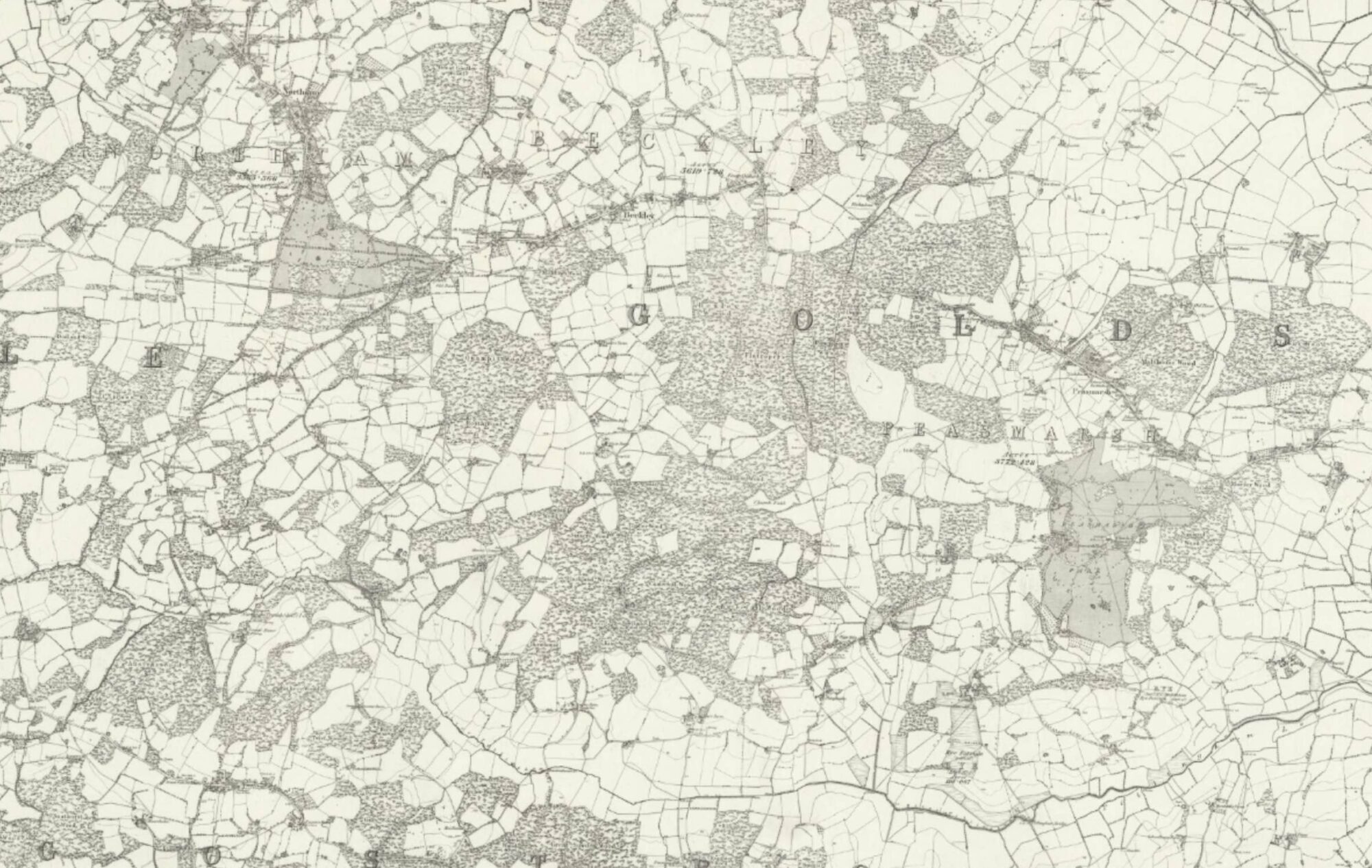We arrived in Eastbourne early one damp morning in January 1988 just in time to unload a few delicate items from the car before the smart blue van of Abels Removals backed up to the elegant entrance of South Cliff Tower on the western end of the seafront. We had come from 2500 square feet in the bungalow to 1500 in the apartment: we had a quart-into-a-pint-pot situation. Knowing this, we had already rid ourselves of a deal of furniture before departure. So, as the removal men unloaded, pretty well everything had a specific spot to go to. But still a couple of rooms had to be stacked high with unopened boxes containing books (about 1500, I’d guess) together with hundreds of LPs. They took many days to sort and place.
A move is always a bit traumatic. But this was our 27th together and we worked to a well-rehearsed rhythm. The apartment needed hardly anything doing to it, mainly rather more careful cleaning than our previous occupants had apparently been accustomed to. It was a very pleasant home. The building had 19 floors with 2 apartments on the ground floor and 2 on the top – penthouse – floor; and 4 apartments on each of the remaining 17 floors; thus a total of 72 apartments. Ours was on the first floor where, unusually, there were two large 3-bedroom apartments facing the sea and two small 1-bed at the rear. We had two fully equipped bathrooms and I used the third bedroom as a study; we enjoyed four large windows – half of the building’s frontage – facing the sea. All the apartments above us, apart from the two penthouses, each had two windows facing the sea. All the windows were double-glazed – of the two-inch gap style which must have been common in 1965 when the Tower was constructed. In front of the building were communal gardens; beyond them, the promenade and paths down to the sea; in the summer I would be in the sea within five minutes of leaving the apartment.
The strange rules of the United Kingdom in the matter of apartments meant that we were purchasing leasehold. I would consider the question of collective freehold later. For the time being we had enough to think about – settling in, getting to know neighbours and staff (we had three porters), preparing for a rather special Anniversary, planning holidays and organising a new car. Within a couple of years that subject of collective freehold would occupy my attention more than somewhat.
The special Anniversary was so soon after our move that we had had to plan much of it from Norfolk; it was our Ruby Wedding on 7th February. We decided to hold a luncheon in the RAF Club at 128 Piccadilly. Our small gathering of guests were all the family – Peter and Tricia, Richard and Sue, Jonathan and Isabel; cousin Joan and Doug; dear friends of Pat, Audrey and Edna Edwards; old friends of mine, Alan Clark and Barbara, and Jack and Gladys Jenkins to represent the RAF. The sad thing was that neither the Best Man, my brother Ken in Spain, nor the chief Bridesmaid, Pat’s sister Betty in South Africa, were able to attend. But nevertheless we both thought it a very happy occasion.
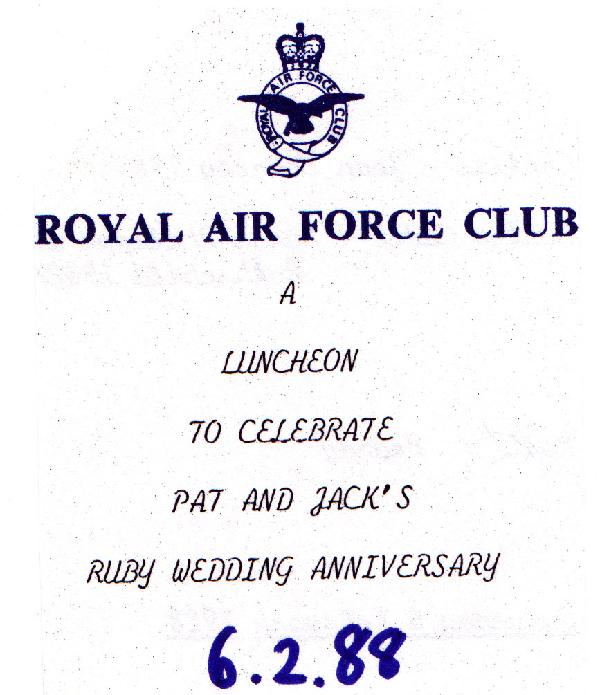
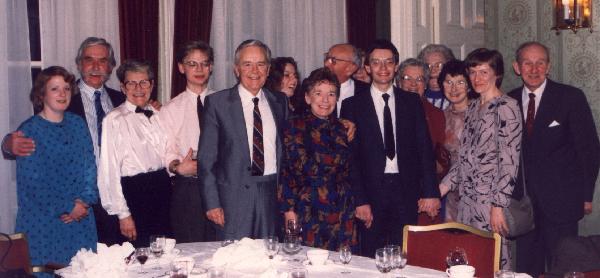
One of the other high spots of the year 1988 was our visit to Richard and family who were now living in the Netherlands. When I say family, it had increased again: little Claire, a sister for Julia, had arrived; thus bringing our total of grandchildren to five. Richard had taken a post of Actuary to an Insurance Company based in Hoofddorp (“Chief Village”) near Schiphol Airport, on the outskirts of Amsterdam. It was most interesting to look back on the history of Hoofddorp. Until 1850 its position was in the middle of a large lake (“Haarlemmeer”) of about 200 square kilometres. The then King masterminded the total reclaiming of the whole lake area and today it is encompassed by a continuous ring of canals (the Ring Vaart) to control both flooding and irrigation. On this and subsequent visits, we saw many other intriguing sights of the country with Richard and Sue: the defensive barrier at the mouth of the Schelde created as a result of the disastrous break-in of the sea in 1953 and highlighted by a startling exhibition at “Delta Expo”; the motorway barrier enclosing the vast Ijsselmeer; the canals, museums and galleries of Amsterdam – particularly the Van Gogh; the flower festivals at so many different places; and the wonderfully efficient flower market at Aalsmeer where we really learnt what it means to see a “Dutch Auction” with buyers pressing buttons as the price indicator gradually reduces; all in all, an impression gained of a highly prosperous community, making the most of its cramped space and ever conscious of its fight against the sea.
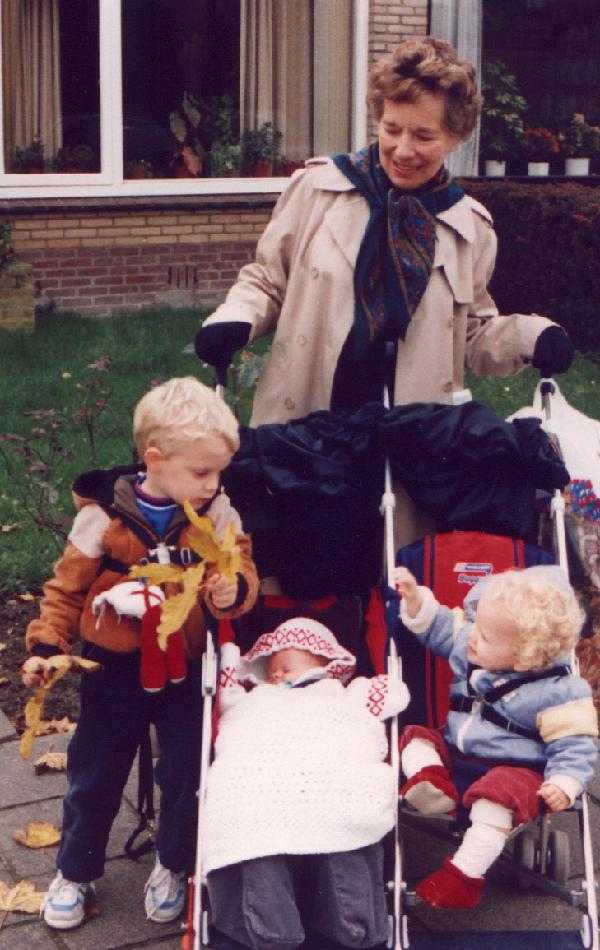
On one of our visits to the Netherlands, we took the opportunity to travel south before coming home, revisiting Paris and Louveciennes, the village in which we had lived 25 years before.
The buildings which had once been the home of SHAPE were now taken over by a well-known French electronics Company: the bold name BULL seemed appropriate somehow. Thence to Giverny to be entranced by the genius of Monet.
Around about this time, in 1988, I decided to have a go at the “entrance exam” for Mensa. You take the first one at home and have to be honest with your timing: they marked my IQ at 161. That led to a controlled exam along with others in a proper testing environment at a College in Lewes, which yielded 155.
It was a good year, too, for the theatre and concert hall. In London Pat and I saw Les Miserables and 42nd Street and enjoyed them both; with Jonathan, who had a liking for Philip Glass’s music, the ENO’s Planet 8. At the Chichester festival, there was Ring Round the Moon and The Royal Baccarat Scandal – the latter particularly intriguing. In Eastbourne itself, we saw The Boy Friend, Follies, Habeas Corpus, Verdict, Macbeth, Wuthering Heights and Love from a Stranger; attended concerts by the Royal Philharmonic, the Berlin Symphony and the Eastbourne Sinfonia; and were taken on a tour of the Glyndebourne Opera House. A truly hedonistic life-style, you might say – and to cap that, I was planning some very extensive travel for the following year – 1989.
Yes, 1989. We planned that in that year we would cover a lot of ground. Both of us had always retained a soft spot for the western states of the USA and I was itching to get back there, in the wide open spaces, driving wherever we chose, stopping as we wished in motels, and seeing again as many of the western National Parks as possible. And we were going to do it twice in 1989. It sounds crazy but the first visit to the USA was to be an aperitif for a complete round-the-world trip. We chose different companions for the two enterprises: Bar and Alan Clark to come with us on the States trip; and subsequently my cousin Joan and her husband Doug around the world. I did nearly all the planning for both journeys: Joan and Doug separated from us for a week or so whilst they visited friends in Perth and we pressed on through Sydney to New Zealand. The USA trip covered three weeks in May, exactly the same period we had been fortunate with in 1954; it involved four flights – London to Minneapolis-St Paul and Los Angeles and return. Round the world took 40 days in September and October, months which seemed to offer a sensible compromise for weather in the two hemispheres; it involved 15 flights, east about, through Schiphol, Dahran, Karachi, Colombo, Singapore, Melbourne, Sydney, Auckland, Honolulu, Los Angeles, Schiphol again and home, plus three internal flights in New Zealand. This was all happening at about the time that “Camcorders” were becoming popular for boring your friends with on return. I took full advantage of the technology and compiled a couple of videos with titles, music and commentary. I also put together afterwards lengthy descriptive logs which occupied about 50 pages of A4. Let me pick out some of the events and comments.
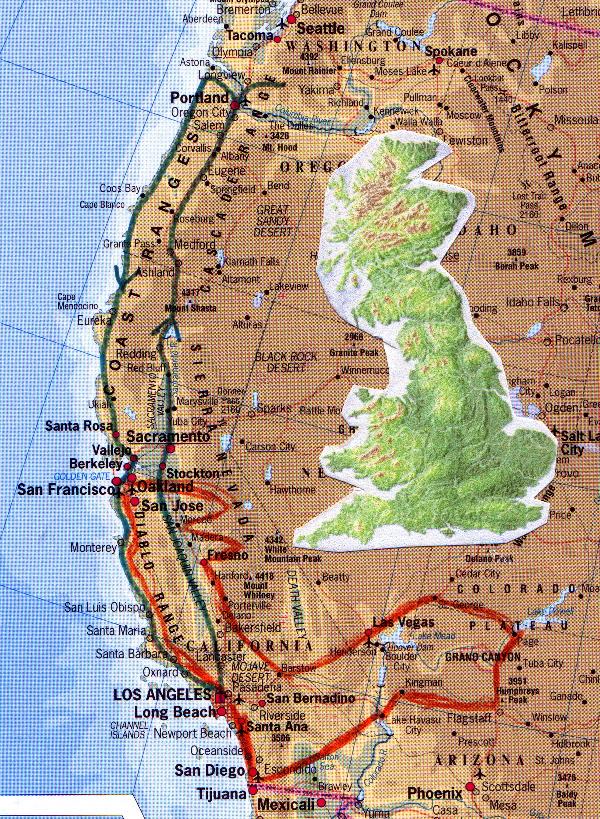
After being greeted and hosted first by an American friend from the 1950s in Oceanside (Bolling Robertson, see Chapter 9) and then by Ken’s previous wife Daphne and son Kim in San Diego, we set off east in our hired Buick. Saturday 13th May… Continuing north on US 95, we arrived mid-afternoon at Lake Havasu City, a comparatively new town on the lower Colorado river. We booked into the Sandman Inn and then went off to see the wonder of the place – the original London Bridge – taken down stone by stone and reassembled in what was at first desert. Now it has a branch of the Colorado river, suitably diverted, running under it and it looks great…
Sunday 14th May… from Tusayan we drove the remaining few miles for our first sight of the Grand Canyon for 35 years. It was still as breathtaking. From a continuous plateau, almost featureless except for a few trees, suddenly there is that great awesome chasm. Unbelievably deep, and long, and wide. In fact, 5000 feet, 200 miles and 10 miles respectively. The buttes and columns, the different colours, the grandeur, quite unforgettable…
We stayed in the Canyon area for three days – and then on to a sight higher up the Colorado.
Wednesday 17th May… Page was a new city that had been founded to construct a dam over Glen Canyon. The effect of the dam was to create Lake Powell, a vast area of water 500 feet higher at the dam end than the original river. At 7.30 am we set off from Wahweap on a 5-hour boat trip across part of Lake Powell. The Lake is 186 miles long and has 2000 miles of coastline (longer than the Pacific coast). The boat trip was wondrous. We were at the bottom of many canyons on water. The canyon approaches became narrower as we progressed and we all stepped out for half an hour to absorb the majesty of the “Rainbow Bridge”, a natural rock archway 300 feet across and high. Then back to the boat to reverse the journey to Wahweap; it was a wonderful trip. The river goes on down from the Glen Canyon dam to flow and rush through the Grand Canyon, thence to Lake Mead at Boulder near Las Vegas, created by the Hoover dam, thence further south to Lake Havasu City where we were four days ago…Thursday 18th May… Bryce Canyon is one of those spectacles where you are high up and you look down on it. (Zion is the other way round.) Along the 20-mile observation route there are half a dozen stopping points. What we saw was quite fantastic – in the true sense of the word. High, delicate columns of pink rock, weathered into different shapes and sizes, looking, in the mass, like thousands of organ pipes and cathedral monuments. In a climate less dry they would have long since crumbled away. But in the remarkably arid air of Utah they hold their shape as they point to the sky…
Friday 19th May… We took the turnoff at Mount Carmel Junction to enter the boundary post of Zion National Park. Emerging from a tunnel into dazzling sunlight, we could now see the winding road that was to take us down to the Canyon floor. We travelled slowly along the length of the paved road which twisted and turned as it followed the course of a swift-flowing river. Mountains, huge rocks and cliffs of many hues went past, trees bursting from the most unlikely spots up the steep sides. Rich vegetation spread its greenness along the floor of the canyon. The whole scene seemed prehistoric. A huge slab of isolated cliff called “The Great White Throne” was particularly impressive. Near it was the phenomenon known as the “Weeping Rock” where you can stand under an over-hanging cliff and see and hear the continuos dripping of waters that have been seeping through from above for millennia…
Our journey took us next to Las Vegas (“The Meadows”!) and later past Edwards Air Force Base to Bakersfield and on to Porterville.Sunday 21st May… Soon we were entering the boundary of Sequoia National Park. The road now started to rise more quickly, winding its way to 6000 feet and following the bed of a swift-flowing river. Wild flowers grew in profusion; the air was sweet and warm. At 6000 feet we began to see the giants. Our first specimens were called the Four Guardsmen: they straddled the road like sentries. Then more – and still bigger – they came. General Sherman was the biggest: indeed, it is the biggest and longest-living thing in the world, starting its life around 700 BC. We picnic-ed among the giants: we were warned by signs not to feed the bears and not to let them in the public loos. Sadly, we encountered no bears…
Monday 22nd May… Before descending into the Yosemite Valley, we took the long detour which climbs eastwards to the south of the valley and were able to view the whole scene from 5000 feet above it, at Glacier Point and Washbourne Point. Two sets of double falls were below us; and the Half Dome shone directly in front of us and at the same level. We returned to the principal road to enter the valley and soon came to the panorama which I well remember took our breath away in ’54: El Capitan on the left rising a sheer 5000 feet, Bridal Veil Falls rushing down to the river on our right and the Half Dome way off in the centre distance. A beautiful sight which can almost be repeated at a particular spot near Lauterbrunnen in Switzerland…
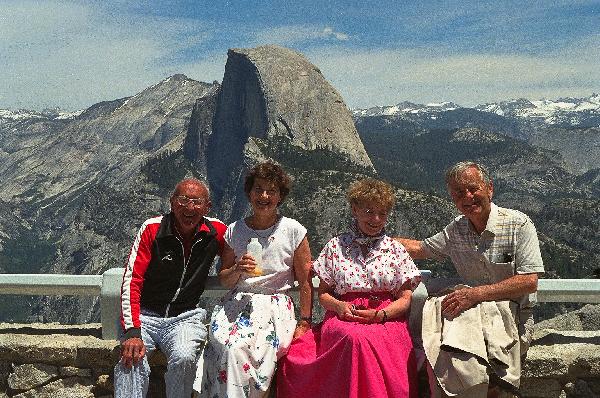
After the beauties of Yosemite, we spent three very happy days soaking up the atmosphere of San Francisco, without doubt one of the more interesting cities of the USA, then a slow drive down the coast through Monterey, Carmel and Santa Barbara, and finally to the sprawling vastness of Los Angeles before returning home to the UK.
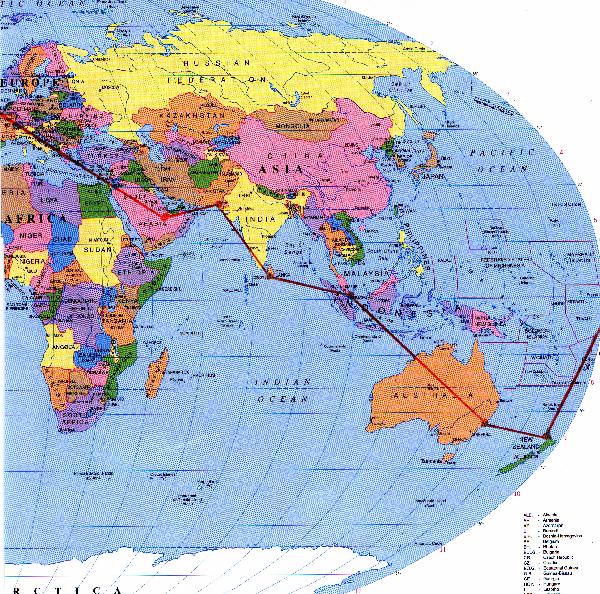
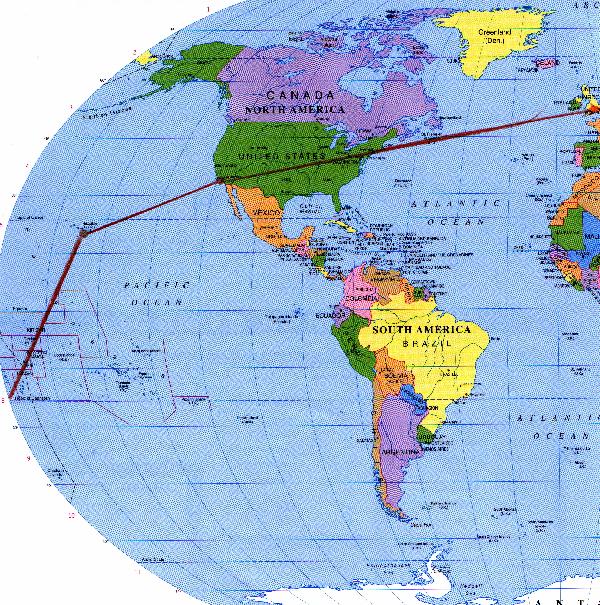
After months of planning and long sessions with Trailfinders in Earls Court Road, our round the world journey began on 26th September. The flight to Karachi from Schiphol was interrupted by an unforeseen landing at Dahran in Saudi Arabia: we had to remain on the aircraft for an hour. By this time we had passed midnight local time so we were now into..
Wednesday 27th September… day 2 which began with a short flight across the gulf and Arabian Sea to that jewel of Pakistan – Karachi. The sun was not yet up (it was 4 am) but the air was warm, and the smell – ah! the smell, such memories! – told us we were definitely in the East. At this point things began to get difficult. KLM had decided in their wisdom that they didn’t like their aircraft staying for any length of time in Sri Lanka because of the political situation. Accordingly, they had changed the flight time for the next leg to Colombo: instead of pressing straight on, they were delaying eight hours. Great, you would suppose: enough to get a decent sleep in. After all, were not KLM paying for hotel accommodation and a subsequent breakfast? Yes indeed, but there were certain formalities to cope with.
To start with, we were all herded into a hot, fan-swept lounge and told to surrender our passports. The actual collection of the passports was a trifle haphazard and took quite a time. Next, there was the question of arranging the hotel accommodation which KLM were paying for, and, of course, the additional matter of coaches to take us all there – and there were some hundreds of us. Suffice to say that the humour of the situation was beginning to wear a bit thin; and many, including Pat, were succumbing by just lying on the floor of the lounge. Even the simple matter of getting some safely drinkable water developed into a Problem. At last, to great Eastern shouts and brouhaha, coaches arrived. In we staggered (the sun was now well and truly up), to be rattled along a distance of little more than 100 yards, to an airport hotel. Bedlam ensued at the reception counter as we all jockeyed for position to fill out forms and collect keys. Doug and I were fairly smart off the mark with our keys; into our rooms; then a frantic search for bottled water which had to be resolved finally by signatures on behalf of the munificent KLM. It was 7 am. We were to be allowed to sleep until 9 am, then all woken by calls. Somewhat early for a midday takeoff, you might think? Not a bit of it!
I recall nudging Doug when we had been driven back to the departure lounge – what system did he think the guys would use for handing us our passports back? Well… it was like this. One man stood up on a podium in front of the only gangway available. He had all the passports with him. Around him in a very large semicircle stood all the hundreds of us. He called out a name which could be heard only by a select few in the front rows; then he held up the photograph page and said “Come on!”. It goes without saying that this procedure didn’t get us very far. Then he had a brilliant idea. He shouted out “Canada – Come on!” and four Canadians struggled to get through to the podium. He hit a bullseye with “Uganda – Come on!”: there was only one. We were getting on! … I’ll draw a veil over the rest of it. At long last we all had our passports back; next we had to undergo the most rigorous security search we were to encounter anywhere round the world.
We were airborne at last for our remaining three-hour flight to Colombo. What a difference – a really charming and efficient welcome to Sri Lanka, speeding through immigration, customs, baggage, on to an obliging guide, handed over to a taxi-driver called “Lucky” Laxton…
Thursday 28th September…Our man “Lucky”, as arranged the previous day, turned up spot on at 8.30 and we were soon hooting and scraping our way through the suburbs of Colombo to head north-east. I have always wanted to travel to Kandy: today we were going. It’s a 70-mile journey and it was to take us 3 hours each way. I understand now why Fodor advises the traveller not to hire just a car, rather a car and a chauffeur. Rusty bikes, beaten-up old trucks, overloaded buses all with their nearside springs gone, old Morris 8s, cattle, chickens, everybody with a hooter using it almost continuously…. all this plus bumpy winding roads gradually climbing into the interior made for exciting driving, to say the least. We passed long lines of specialist wares: at one time stall after stall of cane basketry, at another of exotic fruits. We passed bullock carts and saw elephants being washed in the rivers. Some of the terrain was flat with lush paddy fields, most was mountainous and became more so as we approached Kandy. The day was pleasantly warm but not oppressive: small cumulus clouds developed but nothing came of them.One incident on the road to Kandy bears telling in some detail. At one point we noted that we were passing a number of “Spice Gardens”. Lucky stopped unannounced at the one he considered the best (best commission?). It was No 2 Spice Garden. First of all we were shown round the garden, having all the spice plants pointed out to us. Then we were treated to a lecture – it’s the only word for it. An elderly slim Sri Lankan invited us in impeccable English to sit down in front of him: he talked for some 20 minutes on the efficacies of all the spices that he marketed, showed us albums full of testimonials from all over the world and plied us with cups of a Spice Tea Mixture consisting of – and I quote from the packets he proceeded to sell to us – “Best Tea (Fannings), Cardamon, Cloves, Dry Ginger, Nutmeg and Cinnamon – effective against Rheumatism, Headache, Chills and Colds, Body Pains, Muscle Pains, Stomach disorders, Asthma, and to warm up your body”. Who could resist? We left with pounds of the stuff (in both senses of the word), together with some PROPER curry powder and a eucalyptus/menthol stick which he magnanimously threw in. Before we left we promised to write to fill another page in his album and he came outside in the sunshine to act out his introductory words all over again for the benefit of the video camera. As we drove away he looked very satisfied.
We reached Kandy, a previous capital, and made straightaway for the Dalada Maligawa – the Temple of the Tooth, so-called because it is said to house a tooth of Buddha, rescued from the flames of his cremation at Kusinagara in India. As a religious shrine it was quite impressive. The exact story of the tooth is difficult to unravel, however: Leonard Woolf has claimed he saw it in Kandy before World War I, describing it not as human but canine, about 3 inches long. Of course, say Buddhist scholars: the British have never seen the real thing.
From the Temple, we took a leisurely journey round the lake in the centre of Kandy, much more decorative than you would expect from a mere reservoir, particularly as seen from Gregory’s Road. By this time we were feeling ready for our packed lunches and indicated to Lucky that we should stop somewhere quiet on the road. What does the man do but drive to a hostel and leisure centre run by some friends of his, ask for a table to be set up for our sandwiches and a free issue of Cokes, whilst he gets himself some more substantial curry dish. His friends would not accept a penny for their kindness to us: they were only too eager to please.
Indeed, all the Sri Lankans we met were charming people, trusting, hospitable and kind. Even their political problems evaporated during the short time we were there – a 72-hour ceasefire had been arranged. Of course there was evidence of armed guards and police here and there, but of rebel activity and of violence we saw nothing.
Friday 29th September…For the next flight we were in the hands of Air Lanka. Full marks for their attendance, service and quality of meal. We arrived at Changi Airport, Singapore at 6 pm local time. This was an intriguing moment for me. I last flew operationally from Changi in the summer of 1947 when the whole of the Far East was battered by war and still stricken with widespread poverty and disease. On seeing it again 42 years later, it would be no exaggeration to say that the elegance of the design and operation of the modern Changi Airport puts most other airports of the world to shame. And this was to be the recurring theme through the island of today’s Singapore.
For the next four days we saw as much as we could of this island state: the orchid gardens at Mandai, the cable car flight to Sentosa Island with its musical fountains, the Temple of 1000 Lights which houses Singapore’s largest Buddha, the elegant and impeccably clean Mass Transit System (underground and over), a trip around the harbour on a “bumboat” (a sort of water-taxi), the Science Centre specialising in astronomy, meteorology and electronics, the glittering shopping malls of Orchard Road…
Wednesday 4th October… On this day we were to separate. Joan and Doug would leave first, travelling to Perth, thence to Sydney, before joining us again on the 14th in Auckland… It’s timely to summarise our thoughts about Singapore: a bustling, vibrant city and island state, full of vitality and enterprise, spotlessly clean and tidy. There was much evidence of wealth and little of obvious poverty; nobody begged. Even so, a glance at the salaries offered in the classified columns to many skilled trades indicated to us that there clearly existed two levels of standard of living – the tourist and the local. The majority of the local people were housed in vast communal apartment buildings; and it was interesting that Lee Kuan Yew, who more than anybody has been responsible for Singapore’s resurgence since the 1950s and, in a way, anticipated what we call Thatcherism, had made sure that cheap housing and subsidised transport systems were widely available to all. As a footnote, the extraordinary thing to my mind about Singapore was that there were NO INSECTS – marvellous, but have they disturbed the ecosystem?
Whilst waiting for our QANTAS plane, who should we meet but a priestly friend from Colombo in his yellow robes whom we had chatted with at Colombo airport. He was about to return to Sri Lanka. We exchanged names and addresses – he was the Deputy High Priest in Kandy. He wished us happiness and prosperity: we hoped for peace in his lovely island. He also expressed surprise that we – Europeans – should talk to him at all, which made us wonder what sort of Europeans he’d met before.
We flew through the night, landing at Melbourne at dawn, then on to Sydney. We made the most of two clear days in Sydney: we listened to very clever buskers on the Circular Quay, including a talented Abo performing beautifully on a dulcimer backed by a synthesiser; we visited the Opera House (of course); we took a boat trip around the harbour and under the famous bridge; we walked through the Chinese Garden and the Exhibition Centre; we boarded a monorail for a circular trip around the harbour, and above downtown Sydney; we sped up in one of the lifts of the Centrepoint Tower and spent time rotating through 360 degrees and looking out at the phenomenal visibility; and from our hotel based in the King’s Cross area, we took a stroll at night down Darlinghurst Road to research the seamier side of Sydney life.
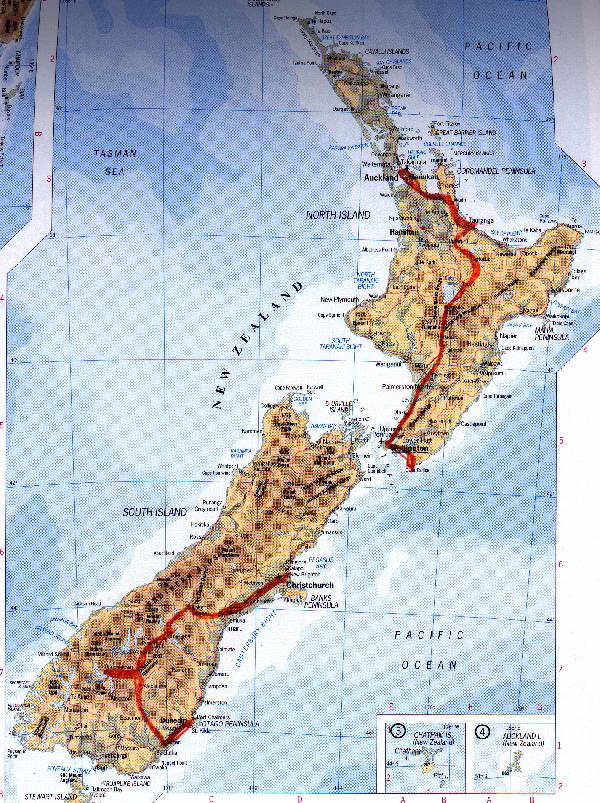
On 7th October we were in the hands of United Airlines flying us to Auckland. We landed at Auckland (12 hours advanced on GMT) in heavy rain and a thunderstorm, organised ourselves a car, found a motel only five minutes away from the airport and after a splendid meal of New Zealand lamb chops, made telephone contact with the three groups of friends we were intending to visit. Two of the connections were from Pat’s childhood; the third was a colleague of mine way back in the RAF. Thus we spent the next five days visiting them in turn, at Tauranga and Wellington in the North Island, then Dunedin in the South. Between the first two, we were able to take in the extraordinary sights of hot springs and very active geysers at Rotorua. After saying farewell to Pat’s friend nnear Dunedin, we drove to Queenstown on Lake Wakatipu, a beautiful leisure centre renowned for boating, surfing, fishing and skiing, the lake surrounded by a range of mountains known as the Remarkables. Near there we saw our first “bunji” jumpers – something I might have enjoyed 50 years previously, but not now! We then set off for Lake Pukaki, a fast run, along plateaux and desert, with mountain ranges all around us, the highest to the west, the Southern Alps. It was a long run, with nobody else on the road. The sun was low as we approached Lake Pukaki. Now a curious thing happened.
Thursday 12th October… I had assumed from the map that Lake Pukaki was a town as well as a lake, and I expected to see the customary motel and eating place. But it was not to be: as the sun began to set, we could see that Pukaki was the lake, a dam and nothing else. I got out of the car overlooking the dam. At exactly the same time an old red truck with a dog in the back came from the other direction and stopped on the other side of the road. A man got out and said G’day. I said Hi there. We chatted for some time. He was a weather-beaten old chap with Jackson Hole on his cap (Wyoming I presume). He had travelled a lot, he said; Banff in Canada, for instance, and how cheap it all was. He’d like to do China, Trans-Siberian, Scandinavia, UK – and could he get to the Isle of Man once he’d got to Scotland? Too easy, I assured him. Anyway, the sun was almost down; he had said he was local; could he advise on accommodation and eating we asked? No problem, he said. Come off this main road, follow that minor road up there for about 15 miles – everything you want there, cabins, food, the lot. Gee thanks, said I, eager to get going – you mean the road that follows the west coastline of the Lake towards Mount Cook? That’s it, he said. So we took the minor road. Now the point is that according to both maps I had of differing scales there was in fact nothing of any habitation within 50 miles of us once we’d established that Pukaki was only a lake and a dam.
Anyways – sorry, anyway – 15 miles went by in the dusk without a soul about; then 20 miles, each bend you think is going to reveal a collection of buildings. But no. Then – just beyond 20 miles – a shop to the side of the road, near the lake. I got out. The shop was closed. I couldn’t see anything else. I went back to the road, and bless me if an old red truck with a dog in the back wasn’t bearing down on us. I waved him down. Where are these cabins, I said; and the food? He looked at me as if I were a bit tetched and instructed me to follow him. We followed his truck round a couple more bends in the road, then he took off on a dirt track towards a lone house in the distance, stopping briefly at the front, then carrying on round the back. We stopped when he stopped, then followed him round the back. He was putting his truck under cover in a carport at the rear. Get back to the front, he said, looking quite cross with me. Hoot your horn and knock on the door.
Round to the front, hooted, knocked – nearly dark now. A rather austere lady came to the door looking like the wicked witch of the West in Oz. Could she possibly help us out with some accommodation, I asked, and where can we eat? Ah well she said; her husband was responsible for matters like this, she’d try and get hold of him. Then followed a Citizen Band radio call with 10-4s and Come-ins and all that, but of her husband, not a word. Was he the gentleman in a red truck with a dog in the back, I enquired. That’s him, she said. I thought to myself – why didn’t he tell us in the first place he owned the cabins himself. I asked her, but she was non-committal.
It was dark, we couldn’t see any cabins, and Pat had that Hitchcock look on her face. So we waited a bit, and the lady finally consulted a reservation book and handed us some keys. Fine, I said, now what about eating? Ah well, she said, I don’t know whether he had planned to open up the shop – that’s his responsibility – or whether he thought you would eat with us. So we waited some more and talked: I said her husband was quite a traveller what with Banff and thinking about China and the Trans-Siberian and the Isle of Man and all. Ach, she said, he dreams these things.
At this point, I really felt I had to bring the situation to a head. It was dark outside and I didn’t even know where the cabins were yet. If we couldn’t get the shop open was there any other way we could get some food? Now I can see you’re the impatient sort, she said. (!) I’ll get some stuff from my larder and you can pay for it. Gladly, I said. Five minutes later, armed with eggs, beans, butter, bread, etc – and please don’t bother with the change – we set off with the necessary navigational data to find those cabins. Go back to the shop, take off on a gravel path to its left, curve around for a bit, and you can’t miss ’em. They’re right on the lakeside.
And so they were. Heating, fully equipped kitchen, the lot. We had a splendid meal and a lovely night’s rest in the mountain air. But I’d love to see old Jackson Hole again and ask him a few more questions.
Friday, 13th October… And what a dawn on Friday the 13th!. It was so stunning out of the kitchen window I set up the video camera to record one second in each five just before the first glint came over the distant hills and the sun started its swing round to the north. We photographed Mount Cook to the west and watched the swirling mist on the upper reaches of the lake where the cold of a glacier met the light blue waters.
We drove to Christchurch, which we liked very much – very English, punters on the Avon river, statues of Scott and Cook, choristers in the cathedral, a floral clock; and the next day flew back to Auckland where we teamed up again as a foursome with Joan and Doug and prepared for our next long flight.
Sunday, 15th October… Two thirds of the way through the flight, probably near the equator – our second crossing – the aircraft had to go through the tops of a line of CuNimbs and there was a fair degree of turbulence for some minutes. One sudden drop was quite a corker: anybody not strapped in, including a stewardess just ahead of Pat and myself, was flung clear to the ceiling. It was just like old times in the Dakotas.
We landed at Honolulu at 6 am local time Sunday and took a taxi to our hotel, the Outrigger Edgewater. It was about 100 yards back from the renowned Waikiki beach. Not surprisingly, our rooms were not ready: unshowered and unshaven we took a bus to Pearl Harbour where we listened to a briefing and a film on the infamous happenings of 7 Dec 1941, and then boarded a boat to take us out to the USS Arizona Memorial built over the rusting superstructure of one of the sunken battleships. I asked one of our companions on the boat, an American whose primary interest was history, to what extent he thought Roosevelt had invited the attack. He considered the word “invited” inappropriate – rather “did not prevent”. A most interesting, if sombre, visit. Many Japanese there seemed to find it interesting too.
Monday, 16th October… I started the day with a swim in the Pacific at 7 am – wonderful – nobody else about.
Today we hired a car from Budget with the idea of touring around the island of Oahu: I had plotted a route which would take us about 120 miles. The general idea was to head east from Waikiki, travel up the east coast of the island, from the most northerly point follow the west coast as far as Haleiwa and then strike southwards through Wahiawa and the centre of the island to Pearl and back to Waikiki.
The day was fine and warm; clouds were building over the mountains as they do most days. We passed Diamond Head Crater and made our first stop at Hanauma Bay, a delightful spot with sandy beach, palms and coral; then to the Halona Blowhole where our patience was rewarded by seeing the seaspray spouting from a hole in the rocks; around the eastern corner of Makapuu Point and inland for a spell to take advantage of wonderful views from the lookout point at Nuuanu Pali high up in the mountains. Back to the east coast for a picnic lunch beside an offshore island appropriately called the Chinaman’s Hat. On up the coast through banana and mango groves, past a Polynesian Cultural Centre and a Mormon Temple, sugar canes and sugar mills, golf courses and satellite com stations. Now we were round the northern tip and heading down the west coast; soon we came to the Waimea Falls Park. We’d have liked to stay longer here – it could fill a whole day – but time was pressing. At Haleiwa we struck inland and were now travelling down the other side of the mountain range which had risen to our left all the way up the east coast. Near the centre of the island we came upon the Dole Pineapple Pavilion which publicised the cultivation and processing of the pineapple fruit. Then it was fast motorway most of the way back to Honolulu.
But before handing in the car at the end of the day, we turned off the busy motorway in Honolulu for one more visit – to Punchbowl Crater, an extinct volcanic crater which has long been greened and set aside as a military cemetery for all US personnel who died in the Pacific theatre of World War II. Murals display the campaigns, all names are engraved on stone. A tranquil and dignified place so close to the teeming bustle of Honolulu and Waikiki.
After a “smorgy” dinner, we took a leisurely stroll through the Royal Hawaiian Shopping Center. The word Royal is interesting. The mall was part of a complex centred on the Royal Hawaiian Hotel, probably one of the most up-market in Waikiki. And the Hawaiian flag has the Union Jack in one corner. We know that it was the ubiquitous Captain Cook who was the first European to land in the Islands in 1778 but he was killed in Hawaii the following year.
One more day in Honolulu was spent catching up on postcards and (for me) swimming in the lovely warm sea; and on the 18th, we would fly to Los Angeles. The radio was full of news which affected our planning in the States.
Wednesday, 18th October… Pretty soon we caught up with the news of the earthquake near San Francisco. Early reports of road and bridge damage made it look as if we would have to change our plans. As the reports became clearer – Oakland Bay Bridge down, Highway 880 damaged, interruptions to gas, electricity and water supplies – we all had to agree, sadly, that it didn’t make sense for outsiders to come in and add to their problems. We therefore drew up a quickly revised itinerary which avoided the immediate San Francisco area.
We settled into our motel on the outskirts of Los Angeles for the first night, and another in Morro Bay, northwards up the Pacific coast for the second. I had planned to show Joan and Doug all the same sights, principally the National Parks, that we had seen in May, but in reverse order. I’ll take extracts from the log only where there is something additional to say.
Friday, 20th October… We were off early on to Highway 1 and within an hour we had reached our first objective – San Simeon. Here we got into a large coach and were driven up and up a hairpin road, into the clouds, finally to reach that extraordinary folly, William Randolph Hearst’s Castle, parodied by Orson Welles in his famous film Citizen Kane. We spent a couple of hours in and around the castle; we had an excellent guide, full of background knowledge and anecdotes; we toured the main reception and dining areas, the guest houses and the indoor and outdoor swimming pools; noting objets d’art and statuary from all over the world. I was pleasantly surprised. I had expected ostentatious vulgarity. The overall effect was tasteful and dignified. Certainly to an American, as opposed to a European, the whole thing might well have looked a trifle odd perched in the California hills. But it was fun seeing it and imagining guests as disparate as Churchill and Chaplin disporting themselves in the guest houses.
Over the following days, having changed route to avoid San Francisco, we investigated Steinbeck territory – Monterey (Cannery Row) and Salinas; toured through the wondrous Yosemite valley once again; the giant Sequoias; past Edwards Air Force Base in the desert, where the latest shuttle from Canaveral had just landed on the longest runway in the world; and on to a strip in the desert of a different kind.
Tuesday 24th October… Las Vegas shrieked at us in the middle of the desert with its glittering towers and its delicious vulgarity: up and down the “Strip” we went, into Caesar’s Palace, past Circus Circus and Las Vegas World, the Sands and the Tropicana, and all the rest, whilst noting that something even more vulgar was to be completed next year – Excalibur, a vast mediaeval gambler’s paradise. We had dinner at the Sahara – $5 for everything you wanted to eat. We were obviously not the sort of customers the Sahara hoped to attract: we took only a cursory glance at the one-armed bandits and the gaming tables. After the meal, we drove down the Strip once more, weaving in and out of the busy traffic, to record on video the scintillating show of illuminations. What a place – great fun for a short visit, but to have to live there!
There followed some days at the greatest geological sight of them all – the Grand Canyon – and then on once again to the charm and gaiety of Lake Havasu City and its London Bridge.
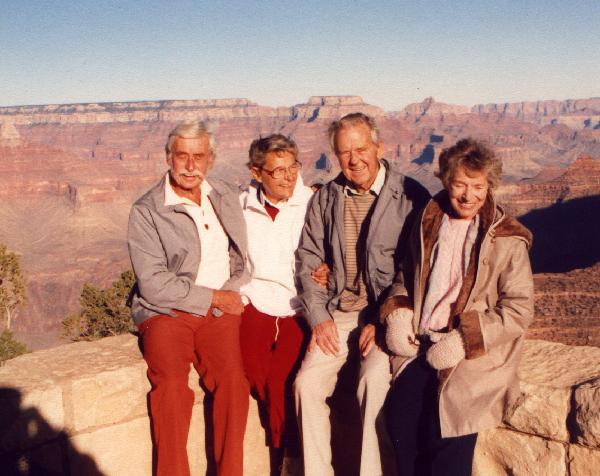
Sunday, 29th October… Before leaving Havasu we took a look at another quaint piece of Englishness. A mile from our motel they had built a new and very clean copy of the Shambles in York, leaning facades and all. And this in the Arizona desert… We headed south on route 95, pausing at Parker dam, yet another interruption to the mighty Colorado’s flow to provide power. At Parker I took a chance on a very minor road which gave us a useful short cut. It ran through Poston to Ehrenberg. It turned out to be the longest and smoothest dead-straight road any of us could remember. It was like one of those films where the telegraph poles go on and on… It also proved to be more interesting, since it traversed the Colorado River Indian Reservation and the area had been made fertile by irrigation from the river. As far as the eye could see, it was cotton, cotton, all the way.
At Ehrenberg we stopped for coffee and a delicious cinnamon bun at a very friendly diner before joining the freeway 10 heading west. As soon as we entered the freeway, we saw a warning of an approaching duststorm: large trucks and vehicles towing trailers were advised to delay. It hit us about 10 miles further on. It was lifted by a stiff wind given a sort of venturi impetus between two mountain ranges. For a time it was like being in a fog, everybody’s lights full on. But it soon passed and we were back in the clear again, with sunshine and cloudless skies.
Freeway 10, through desert and mountains, took us all the way to Palm Springs, an up-market resort elegantly laid out on a plain lying beneath a 9000-foot mountain range. After booking into our motel, we drove out to the base of an aerial tramway where a cable car carrying 80 people rode us up to the top of the mountain in the San Jacinto range. At the peak, we strolled through the pines and watched mule parties straggling along the paths; the air temperature was 39F but the sun was warming. On return to the lower level we drove off, past a thousand or so wind machines, to the Palm Springs Desert Museum, interesting and beautifully presented .
The next day we negotiated many freeways to Los Angeles, each becoming more frenetic than the one before: and on 30th and 31st October, we visited the dear old Queen Mary, anchored in a stretch of water off Long Beach and labelled a “Hotel”; an extraordinary piece of architecture in Garden Grove called the Crystal Cathedral; the Hollywood Bowl and Hollywood Boulevard with everybody’s footprints; the full length of Sunset Boulevard which got more elegant the further west we went; and finally, to the other end of the social scale – Watts, where we marvelled at the patience of one Simon Rodia who many years ago had constructed the Watts Towers out of any old bits of metal and plastic and tile.
We left Los Angeles on 1st November and arrived home in the UK on the 2nd. Thus ended a journey in 40 days of 26,000 miles flying; 4000 miles of car driving; and many memorable sights and experiences.
Now Eastbourne was to take over our lives.
